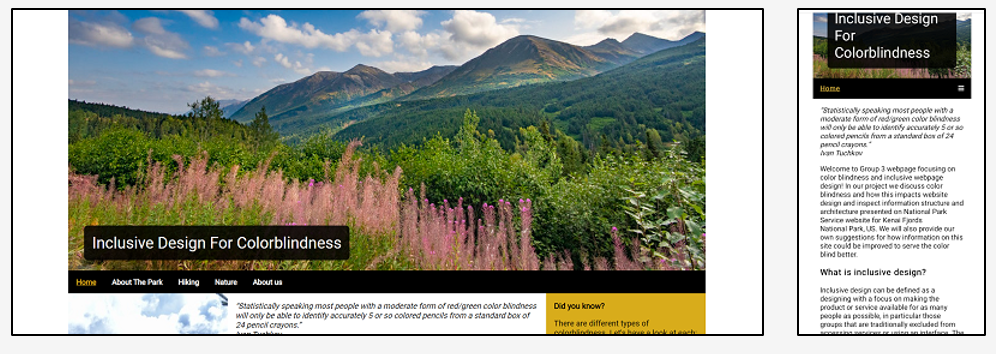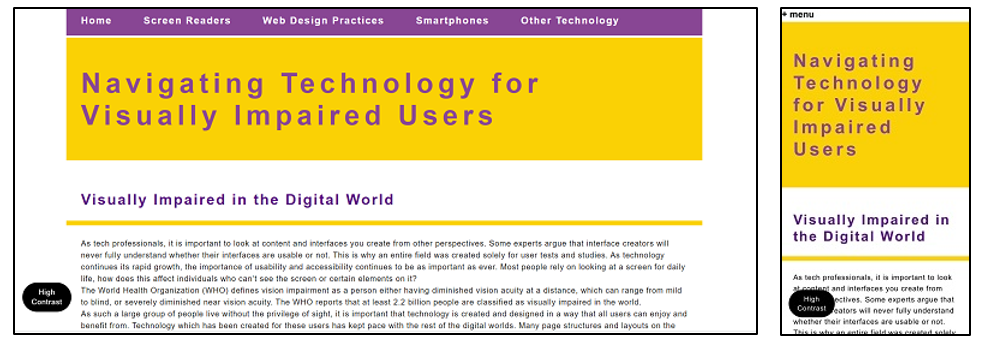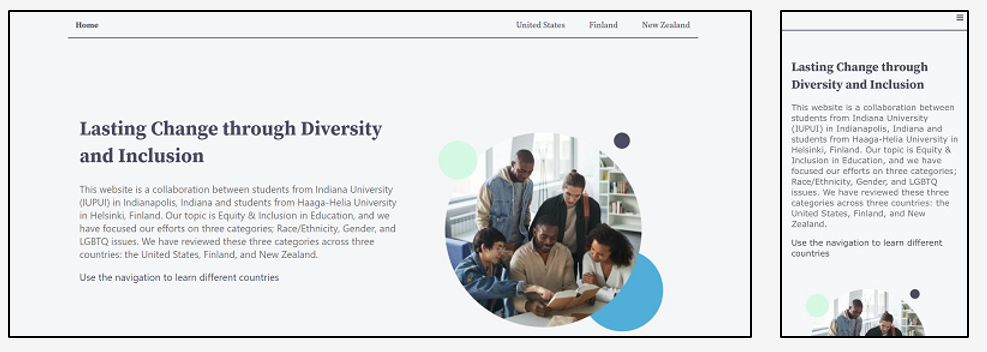Overview
International Collaboration
“Information Structures for the Web” (IUPUI) and “Orientation to Digital Services” (Haaga-Helia) came together in the Spring 2022 semester to conduct an international, educational collaboration. This year’s collaboration built upon the initial groundwork that had been laid between the two schools as part of the Global Classroom Initiative in the Spring 2021 Semester. This year’s collaboration included students from Finland, Russia, Pakistan, Italy, Nepal, South Africa, Germany, Chile, the United Kingdom, and the United States. Students in William Helling’s course (Information Structures for the Web) partnered with students in Kasper Valtakari's course (Orientation to Digital Services); In total, fifteen students from each school participated in the collaboration, with five separate groups working to develop their own respective websites. Students used a variety of virtual platforms and services to work together as a group on their websites. HH students were added to the IUPUI Canvas course as students via their IU guest accounts where they see lectures and submit assignment just like the IUPUI students. Likewise, IUPUI students then joined the Haaga-Helia Microsoft Teams Forums to work on designing their websites. In a further extension of this international collaboration, nine IUPUI students traveled to Helsinki and met with their classroom partners from Haaga-Helia. Over the course of two weeks in Finland, the IUPUI students’ activities included field trips and site visits relevant to the international collaboration, such as Haaga-Helia University of Applied Sciences, as well as to Finnish culture in general via visits to historic sites, museums, industries, and cultural events.
International Themes
This year students were given the main topic of “Diversity, Accessibility, and Inclusion through Technology.” Each group was then asked to develop a subtopic that would become the focus of the content on their respective website.
Web Design & Digital Services
All students covered principles, methods, and techniques to develop web sites and digital services. This course emphasizes the work needed to create valid, accessible, and usable information displays for a global audience. Such effort requires development in both technical as well as conceptual skills. Students came to this course with a wide range of technical expertise and skills, from brand new to HTML and CSS to very experienced at coding.
Timetable
The first 6-7 weeks were spent on introductions, getting familiar with class tools, and studying basics of HTML and CSS. After this orientation, the students were divided into five groups, with a mixed representation of IUPUI + HH students. The last half of the semester these groups collaborated on their own websites. Each group had complete freedom for how they wanted to create their website, as long as it adhered to the technical standards for HTML, CSS, and accessibility. The websites were also required to be responsive and thus suitable for any device. Students used these main tools to collaborate: GitHub, Microsoft Teams, Canvas.
Group 1: Game Difficulty & Intersectionality
Members:
HH:
- Giulia Libe
- Gabrielle Baker
IUPUI:
- David Fiora
- Christina Friesen
- Teryn Morgan
“Gaming Difficulty & Intersectionality” serves as an informational resource regarding the broad spectrum of accessibility and representation issues found in the international video gaming industry. By shedding light on the issues and providing relevant resources, it is desired that this site will be helpful for long-time gamers and gaming novices alike.

Group 2: Designing for Everyone
Members:
HH:
- Kiana Montazeri
- Linnea Moller
- Ola Hoa Phung
- Stephen Swanson
IUPUI:
- Hannah Thompson
- Michael Auer
- Maeve Brewer
The aim of “Designing for Everyone” is to provide insight, education, and resources for anyone interested in accessibility in web design, whether you're a web designer, a person with an impairment, or a curious student. The content focus of this website has been organized into five primary categories: organization systems, text and readability, semantics, responsive web design, and file size.

Group 3: Inclusive Design for Colorblindness
Members:
HH:
- Teija Nurro
- Sakhi Hashmat Khalil
- Julia Tarabarina
- Kiran Thapalia
IUPUI:
- Alexus Hunt
- Michael Marckwordt
- Jennifer Thomas
“Inclusive Design for Colorblindness” focuses on color blindness and inclusive webpage design. In this project the group discusses color blindness and how it impacts website design. This task is accomplished through an inspection of the information structure and architecture presented on the National Park Service website for Kenai Fjords National Park, US. The group also provides their own suggestions for how information on this site could be improved to serve the color blind better.

Group 4: Navigating Technology for Visually Impaired Users
Members:
HH:
- Miska Kyto
- Chi Nguyen
IUPUI:
- Anthony Corvin
- Edwin Fallwell
- Emma Parker
It is imperative that interfaces are created with accessibility for blind users and visually impaired in mind. “Navigating Technology for Visually Impaired Users” details several important ideas and topics that need to be considered when designing interfaces and creating content for blind and visually impaired users. This initiative includes, screen readers and tools, web design: best practices, smartphones and its accessibility features, and more user cases and technology.

Group 5: Lasting Change through Diversity and Inclusion
Members:
HH:
- Artem Kislukhin
- Kikelomo Aiyenitaju
- Liuwei Luo
IUPUI:
- Chloe Antonio
- Sierra Braun
- Cordelia Nervi
“Lasting Change through Diversity and Inclusion” details equity and inclusion in education through a focus on three categories; Race/Ethnicity, Gender, and LGBTQ issues. These three categories are then analyzed and reviewed across three countries: the United States, Finland, and New Zealand, in order to give a global perspective to these topics.

